仁爱版英语八年级上册 Unit 2 keeping healthy教案
- 格式:pdf
- 大小:234.81 KB
- 文档页数:5
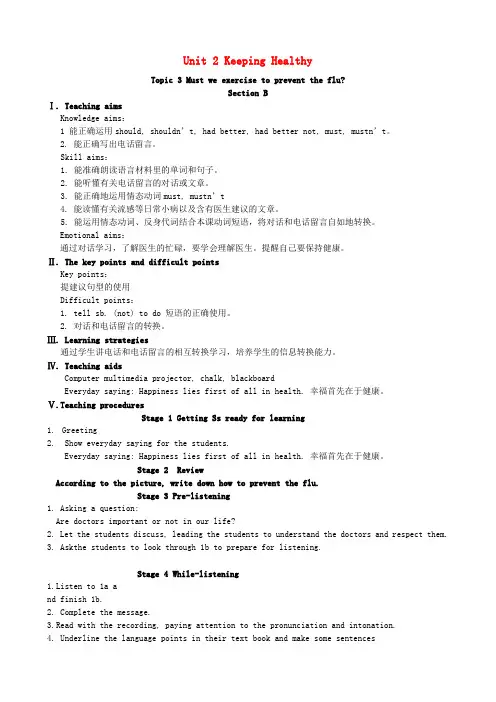
Unit 2 Keeping HealthyTopic 3 Must we exercise to prevent the flu?Section BⅠ. Teaching aimsKnowledge aims:1 能正确运用should, shouldn’t, had better, had better not, must, mustn’t。
2. 能正确写出电话留言。
Skill aims:1. 能准确朗读语言材料里的单词和句子。
2. 能听懂有关电话留言的对话或文章。
3. 能正确地运用情态动词must, mustn’t4. 能读懂有关流感等日常小病以及含有医生建议的文章。
5. 能运用情态动词、反身代词结合本课动词短语,将对话和电话留言自如地转换。
Emotional aims:通过对话学习,了解医生的忙碌,要学会理解医生。
提醒自己要保持健康。
Ⅱ. The key points and difficult pointsKey points:提建议句型的使用Difficult points:1. tell sb. (not) to do 短语的正确使用。
2. 对话和电话留言的转换。
Ⅲ. Learning strategies通过学生讲电话和电话留言的相互转换学习,培养学生的信息转换能力。
Ⅳ. Teaching aidsComputer multimedia projector, chalk, blackboardEveryday saying: Happiness lies first of all in health. 幸福首先在于健康。
Ⅴ.Teaching proceduresStage 1 Getting Ss ready for learning1.Greeting2. Show everyday saying for the students.Everyday saying: Happiness lies first of all in health. 幸福首先在于健康。

仁爱版初中英语八年级上册教案Unit 2 Keeping HealthyTopic 2 I must ask him to give up smoking.Section BTeaching person:Teaching time:one classTeaching aims:1. New words: article , smoke, cancer, litter, dustbin, la wn, energy, necessary, enough2. Learn some useful sentences:(1) How terrible!(2) Don’t walk on the lawn.(3) It’s necessary for your health.(4) Smoking is bad for his health.3. The use of “must ,must not”(1) I must ask him to give up smoking.(2) You must put litter into the dustbin.(3) You must not throw litter around.4. Help students form good habits.Teaching importance : aim 1 ,2, 3.Teaching difficulty:It’s necessary for sb. to do sth.Teaching steps:一、Sing an English song. Then greet between the teacher and the students .二、Review the dialog of Section A..Ask some sentences:Staying up late is bad for your health.Is going to bed early good or bad for our health ?It’s good .Doing morning exercises is good for our health.三、New lesson:(一) 1a1. Read the dialog by themselves . Find the new words and understand their meaning and pronunciation.2.Listen to the tape and read after it.Thinking :What’s the dialog about ?After reading ,answer it .3. Read again and understand the dialog with some questi ons. After reading it ,answer them.1)What is Wang Junfeng reading ?He is reading an article about smoking in the newspaper.2)What does Maria’s father think of smoking ?Because he thinks smoking can help him relax.3)Why does Maria want to ask her father to give up smoking? Because smoking is bad for our lungs and it can even cause cancer.4. After answering them,explain and practice useful phrases. Give some examples .Smoking is bad for his health .I must ask him to give up smoking .The use of “must”.How terrible !(二) 1b1. Read and match the sentences by themselves .2 .Then say the sentences without looking at the book.3 . Summarize the use of “must, mustn’t”--Must I finish the task now ?--Yes , you must.--No, you needn’t.--No , you don’t have to.(三)Look at the picture and say some sentences using “mustn’t, don’t”.For example: You mustn’t walk on the lawn. Don’t walk onthe lawn. You mustn’t climb the tree. Don’t park your bike here and there. Don’t take your pet to the school.You mustn’t throw litter around .(四)2a 1 . Read the following sentences and understand them.2 . Read them after the tape twice .3 . Say the sentences without looking at the book.4. Solve the hard sentences and useful expressions.It’s necessary for sb. to do sth.For example : It’s necessary for us to review often .四、Show some exercises to check the importance.1 . _______ ( smoke ) is bad for your health .2 . We must _______ (follow ) the school rules .3 . Don’t________ ( read ) in the sun .4 . You mustn’t________( stay ) up late at night.5 . ---Must I stop watching TV right now ?--- No , you ______________ .6 . It’s necessary ____ us to know some traffic rules .7. _____ sweet music ! _____ fast he runs ! ( What or How )五、Summarize the useful languages and read them. .六、Homework.Write six sentences using “must , mustn’t, don’t“ 七、The design of the blackboard ,Section B1 . must do , mustn’t do ,---Must I /we do ?--- Yes , you must .--- No , you needn’t.--- No , you don’t have to .2 . How terrible ! What a lovely cat !3. It’s necessary for your health .4 . Smoking is bad for our health .。
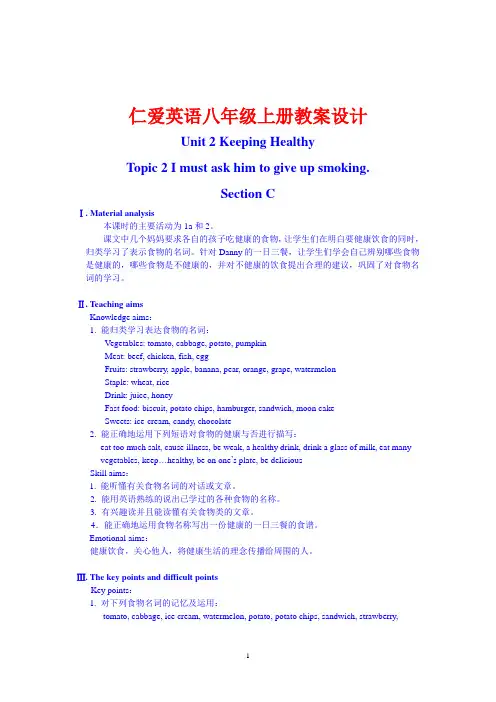
仁爱英语八年级上册教案设计Unit 2 Keeping HealthyTopic 2 I must ask him to give up smoking.Section CⅠ. Material analysis本课时的主要活动为1a和2。
课文中几个妈妈要求各自的孩子吃健康的食物,让学生们在明白要健康饮食的同时,归类学习了表示食物的名词。
针对Danny的一日三餐,让学生们学会自己辨别哪些食物是健康的,哪些食物是不健康的,并对不健康的饮食提出合理的建议,巩固了对食物名词的学习。
Ⅱ. Teaching aimsKnowledge aims:1. 能归类学习表达食物的名词:Vegetables: tomato, cabbage, potato, pumpkinMeat: beef, chicken, fish, eggFruits: strawberry, apple, banana, pear, orange, grape, watermelonStaple: wheat, riceDrink: juice, honeyFast food: biscuit, potato chips, hamburger, sandwich, moon cakeSweets: ice-cream, candy, chocolate2. 能正确地运用下列短语对食物的健康与否进行描写:eat too much salt, cause illness, be weak, a healthy drink, drink a glass of milk, eat many vegetables, keep…healthy, be on one’s plate, be deliciousSkill aims:1. 能听懂有关食物名词的对话或文章。
2. 能用英语熟练的说出已学过的各种食物的名称。
3. 有兴趣读并且能读懂有关食物类的文章。

教学·现场立足单元主题,培养语言运用能力———以仁爱版八年级上册Unit 2Keeping Healthy 教学为例文|杨香梅仁爱版八年级上册Unit 2Keeping Healthy 是一个集知识性与实用性于一体的教学单元。
它以健康为主题,紧密围绕学生的生活实际,通过丰富多样的教学内容和活动设计,旨在引导学生在掌握语言知识的同时,积极运用所学进行表达和交流,从而真正达到学以致用的目的。
一、解读教材,确定单元主题作为教学的第一步,深入解读教材并准确确定单元主题是至关重要的。
教师需要全面理解教材的编写意图、内容结构以及语言特点,从而明确单元主题的教学目标和重点。
通过深入挖掘教材内涵,教师可以更好地把握单元主题与语用能力培养之间的内在联系,为后续教学策略的制定提供有力支撑。
通过仔细研读教材,我们可以发现几个明确的主题线索,它们分别是:“You should see a dentist.”(你应该看牙医。
)“I must ask him to give up smoking.”(我必须让他戒烟。
)以及“Must we exercise to prevent the flu ?”(我们必须锻炼来预防流感吗?)这些主题不但直接关联到学生的日常生活习惯和健康问题,而且通过具体的语境,呈现了丰富的语言运用场景。
每个主题都蕴含着对学生语用能力培养的深刻思考,旨在引导学生通过语言实践,提升自我健康管理能力,同时增强他们的语言交际能力和表达能力。
首先,“You should see a dentist.”这一主题强调了口腔卫生的重要性,提醒学生养成良好的生活习惯。
在教学过程中,教师可以围绕这一主题设计相关的口语交流活动,如讨论正确的刷牙方法、分享个人口腔卫生习惯等,从而让学生在真实的语境中运用所学知识进行表达和交流。
其次,“I must ask him to give up smoking.”这一主题涉及劝说他人改变不良习惯的话题。
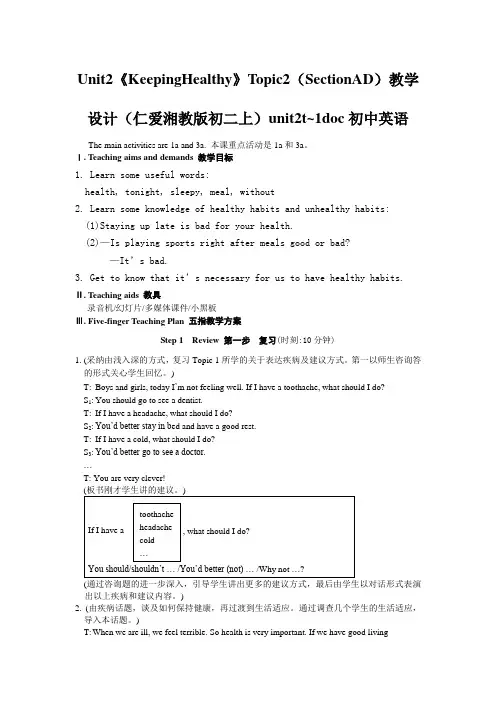
Unit2《KeepingHealthy》Topic2(SectionAD)教学设计(仁爱湘教版初二上)unit2t~1doc初中英语The main activities are 1a and 3a. 本课重点活动是1a和3a。
Ⅰ. Teaching aims and demands 教学目标1. Learn some useful words:health, tonight, sleepy, meal, without2. Learn some knowledge of healthy habits and unhealthy habits:(1)Staying up late is bad for your health.(2)—Is playing sports right after meals good or bad?—It’s bad.3. Get to know that it’s necessary for us to have healthy habits. Ⅱ. Teaching aids 教具录音机/幻灯片/多媒体课件/小黑板Ⅲ. Five-finger Teaching Plan 五指教学方案Step 1 Review 第一步复习(时刻:10分钟)1. (采纳由浅入深的方式,复习Topic 1所学的关于表达疾病及建议方式。
第一以师生咨询答的形式关心学生回忆。
)T: Boys and girls, today I’m not feeling well. If I have a toothache, what should I do?S1: You should go to see a dentist.T: If I have a headache, what should I do?S2: You’d better stay in b ed and have a good rest.T: If I have a cold, what should I do?S3: You’d better go to see a doctor.…T: You are very clever!(通过咨询题的进一步深入,引导学生讲出更多的建议方式,最后由学生以对话形式表演出以上疾病和建议内容。
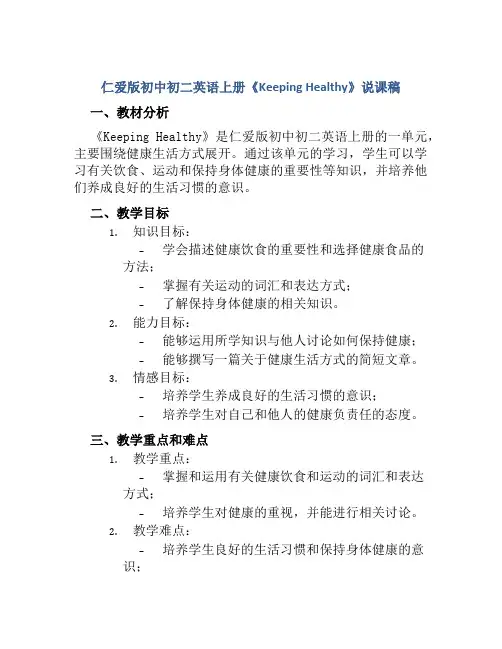
仁爱版初中初二英语上册《Keeping Healthy》说课稿一、教材分析《Keeping Healthy》是仁爱版初中初二英语上册的一单元,主要围绕健康生活方式展开。
通过该单元的学习,学生可以学习有关饮食、运动和保持身体健康的重要性等知识,并培养他们养成良好的生活习惯的意识。
二、教学目标1.知识目标:–学会描述健康饮食的重要性和选择健康食品的方法;–掌握有关运动的词汇和表达方式;–了解保持身体健康的相关知识。
2.能力目标:–能够运用所学知识与他人讨论如何保持健康;–能够撰写一篇关于健康生活方式的简短文章。
3.情感目标:–培养学生养成良好的生活习惯的意识;–培养学生对自己和他人的健康负责任的态度。
三、教学重点和难点1.教学重点:–掌握和运用有关健康饮食和运动的词汇和表达方式;–培养学生对健康的重视,并能进行相关讨论。
2.教学难点:–培养学生良好的生活习惯和保持身体健康的意识;–调动学生积极参与课堂讨论,互相倾听和尊重意见。
四、教学内容和方法1.教学内容:–饮食和健康:•描述健康饮食的重要性;•学习选择健康食品的方法。
–运动和健康:•学习运动的词汇和表达方式;•探讨运动对身体健康的好处。
–保持身体健康的相关知识。
2.教学方法:–组织小组讨论,鼓励学生互相交流意见;–制定小组活动任务,让学生合作完成;–运用多媒体辅助教学,引入相关图片和视频。
五、教学步骤和流程1.导入(5分钟):–利用图片和视频素材引入话题,激发学生对健康的兴趣。
2.预习任务(10分钟):–让学生预习课文,查找有关健康饮食和运动的词汇和表达方式,并记录下来。
3.课文阅读(15分钟):–学生带着预习记录,跟读课文,学习相关知识点。
4.组织小组讨论(20分钟):–将学生分成小组,给每个小组分配一个问题,让他们商讨并整理答案。
–每个小组派代表发言,与其他小组进行辩论和交流。
–教师引导讨论,梳理各组观点,形成共识。
5.观看视频(10分钟):–观看和讨论有关运动和健康的视频素材。
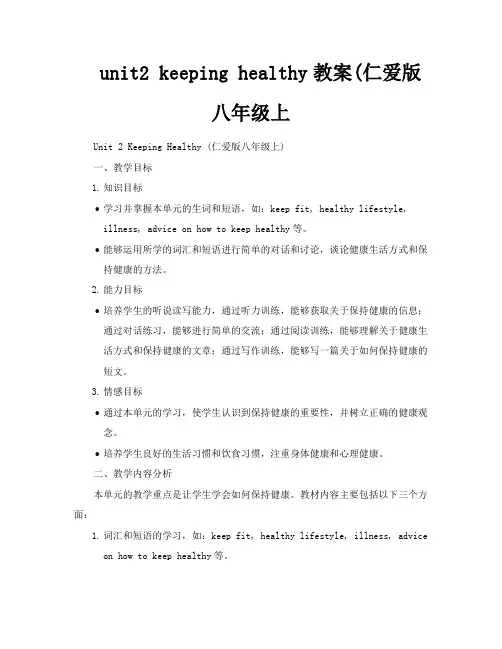
unit2 keeping healthy教案(仁爱版八年级上Unit 2 Keeping Healthy (仁爱版八年级上)一、教学目标1.知识目标•学习并掌握本单元的生词和短语,如:keep fit, healthy lifestyle,illness, advice on how to keep healthy等。
•能够运用所学的词汇和短语进行简单的对话和讨论,谈论健康生活方式和保持健康的方法。
2.能力目标•培养学生的听说读写能力,通过听力训练,能够获取关于保持健康的信息;通过对话练习,能够进行简单的交流;通过阅读训练,能够理解关于健康生活方式和保持健康的文章;通过写作训练,能够写一篇关于如何保持健康的短文。
3.情感目标•通过本单元的学习,使学生认识到保持健康的重要性,并树立正确的健康观念。
•培养学生良好的生活习惯和饮食习惯,注重身体健康和心理健康。
二、教学内容分析本单元的教学重点是让学生学会如何保持健康。
教材内容主要包括以下三个方面:1.词汇和短语的学习,如:keep fit, healthy lifestyle, illness, adviceon how to keep healthy等。
2.听、说、读、写方面的训练,通过这些训练,让学生能够运用所学的词汇和短语进行简单的对话和讨论,谈论健康生活方式和保持健康的方法。
3.通过学习短文“How to Keep Fit”,让学生了解保持健康的正确方法。
三、教学步骤设计1.导入新课:通过引导学生讨论身边的人和事,引出本单元的主题——保持健康。
2.学习新课:通过学习新单词和短语,初步了解本单元的学习内容。
然后进行听、说、读、写方面的训练,让学生能够运用所学的词汇和短语进行简单的对话和讨论,谈论健康生活方式和保持健康的方法。
最后,教师引导学生总结本节课所学内容。
3.巩固练习:通过阅读短文“How to Keep Fit”,让学生了解保持健康的正确方法。
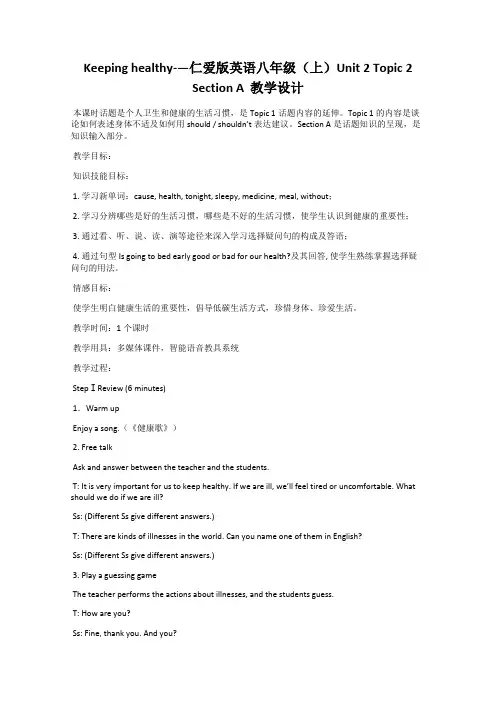
Keeping healthy-—仁爱版英语八年级(上)Unit 2 Topic 2Section A 教学设计本课时话题是个人卫生和健康的生活习惯,是Topic 1话题内容的延伸。
Topic 1的内容是谈论如何表述身体不适及如何用should / shouldn’t表达建议。
Section A是话题知识的呈现,是知识输入部分。
教学目标:知识技能目标:1. 学习新单词:cause, health, tonight, sleepy, medicine, meal, without;2. 学习分辨哪些是好的生活习惯,哪些是不好的生活习惯,使学生认识到健康的重要性;3. 通过看、听、说、读、演等途径来深入学习选择疑问句的构成及答语;4. 通过句型Is going to bed early good or bad for our health?及其回答, 使学生熟练掌握选择疑问句的用法。
情感目标:使学生明白健康生活的重要性,倡导低碳生活方式,珍惜身体、珍爱生活。
教学时间:1个课时教学用具:多媒体课件,智能语音教具系统教学过程:StepⅠReview (6 minutes)1.Warm upEnjoy a song.(《健康歌》)2. Free talkAsk and answer between the teacher and the students.T: It is very important for us to keep healthy. If we are ill, we’ll feel tired or uncomfortable. What should we do if we are ill?Ss: (Different Ss give different answers.)T: There are kinds of illnesses in the world. Can you name one of them in English?Ss: (Different Ss give different answers.)3. Play a guessing gameThe teacher performs the actions about illnesses, and the students guess.T: How are you?Ss: Fine, thank you. And you?T: I’m not feeling well. (The teacher performs the actions about different illnesses)Ss: Do you have a headache / cough / stomachache...?4. Ask and answer between theteacher and the studentsShow some pictures about illnesses on the slides. Make dialogues and practise them.T: My friend is feeling terrible.What’s wrong with her / him?Ss: She / He...T: What should she / he do?Ss: She / He should / shouldn’t...Step Ⅱ Presentation (10 minutes)1. Talk about the picture in 1a, and look at the following questions.(1)Can you guess what’s wrong with Kangkang?(2)Why does he look like this?2. Let the students listen to 1a and answer the following questions:(1)What’s wrong with Kangkang?(2)Did he watch a soccer game on TV last night?(3)Is staying up late good for his health?3. Have the students read 1a and find out the new words and useful expressions. The teacher explains the key words and phrases.板书:4. Get the students to listen to 1a and read after it sentence by sentence. Imitate the pronunciation and intonation.Step Ⅲ Consolidation (15 minutes)1. Pair work. Divide the class into two groups (Boy group and Girl group) to read 1a, then act out 1a in pairs.2. Encourage the students to complete and retell the dialogue in 1a according to the key words and phrases.3. Encourage the students to describe what caused Kangkang to feel tired and give some advice in their own words.4. Create a scene. Let the students practice 1b in pairs. Finish 1b.5. Work alone. Listen to 2 and check(√)what Wang Junfeng did and what he should do. Learn and master the word “medicine”.T: Next, we’ll learn something about Wang Junfeng. Please look at 2 on Page 33. Go through the phrases in 2. Then listen and check(√) what Wang Junfeng did and what he should do. Why did Wang Junfeng get a headache? Should he take some medicine?板书:Step Ⅳ Practice (10 minutes)1. Ask and answer between the teacher and the students. Talk about “habit”. Let the students learn and master the word“habit”.T: In our daily life, everyone has some living habits. Good living habits make us healthy. However, bad living habits are bad for our health. Let’s look at the screen and discuss whether these living habits are good or bad for our health.T: (Show Picture 1) Is it good or bad for our health?Ss: It’s good.T: (Show Picture 2) Is it good or bad for our health?Ss: It’s bad....2. Group work. Discuss how to keep healthy, meanwhile show some pictures to help them. Learn and master “meal, fingernail”.板书:3. Pair work. Finish 3a, discuss these habits after the example.T: Now please look at the screen. Are these habits good or bad? If they are bad, write good ones on the lines.(One minute later, check the answers)T: Let’s check the answers together. Is going to bed early good or bad for our health?Ss: It’ s good.T: Is getting up late good or bad for our health?Ss: It’ s bad....4. Work in groups. Show some other living habits. Let the students discuss whether these living habits are good or bad for our health. Finish 3b.板书:S1: Is getting up late good or bad for our health?S2: It’s bad for our health....5. Show some wise sayings about health. Help the students learn how to keep healthy.(1)A close mouth catches no flies.病从口入。

Unit2KeepingHealthyTopic1SectionB教案Unit 2 Keeping Healthy Topic1 Section B教案仁爱版八年级上Unit 2 Keeping Healthy Topic1You’d better go to see a doctor.Section B 教学设计The main activities are1aand2a. 本课重点活动是1a和2a。
Ⅰ. Teaching aims and demands 教学目标1. Learn some new words and phrases:pale, terrible, day and night, feel like doing, lie down, candy, brush, tooth (teeth), Internet, care, take care of2. Learn some useful sentences:(1)I’m f eeling terrible!(2)How long have you been like this?(3)How are you feeling, Nick?3. Go on learning some modals for giving advice:(1) You’d better go to see a doctor.(2) Why don’t you have a good rest?(3) You should lie down and rest.(4) You’d better not drink cold water.(5) You shouldn’t eat too much candy.4. Get students to know how to take care of themselves and others.Ⅱ. Teaching aids 教具卡片/教学挂图/录音机/小黑板/药片/水杯Ⅲ. Five-finger Teaching Plan 五指教学方案Step 1Review 第一步复习(时间:5分钟)师生互动,通过对疾病表达及建议的复习,导入新课。
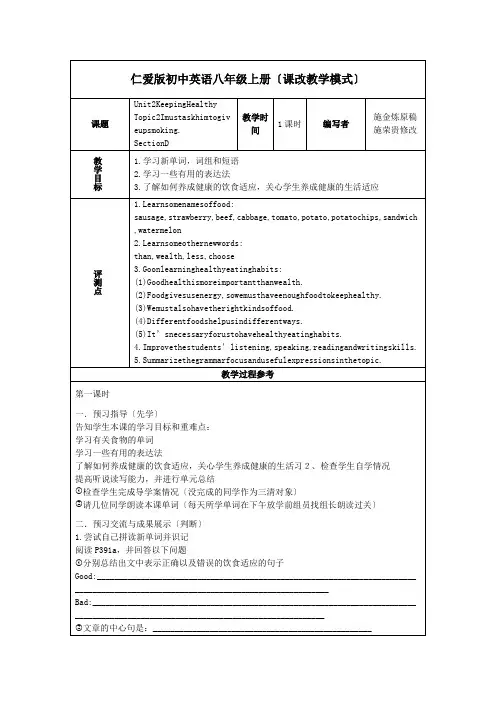

Unit2 Keeping HealthyTopic 1 You should bru sh your teeth twice a d ay.Ⅰ.Teaching aims and demands 教学目标1. Learn some new words and phrases:toothache, dentist, have a cold, cough, take a rest, fever, flu, headache, at night, coffee, tea, plenty, plenty of, boiled water, lift2. Learn some useful sentences:(1)I have a toothache.(2)I’m sorry to hear that.(3)I have a bad cold.3. Learn the modals for giving advice:(1)You should see a dentist.(2)You shouldn’t drink coffee or tea in the evening.4. Talk about illnesses.5. Learn to express sympathy for a patient and give some advice to the patients.Ⅱ. Teaching aids :PPTⅢ. Teaching Method:TBM.Step 1 Warming upStep 2 Presentation通过师生对话及听力活动,呈现1a内容,学习部分生词与短语,培养学生的听说能力。
1. (师生对话,谈论健康话题。
)T: In this lesson, let’s talk about health.T: How are you feeling today, S1?S1: I’m fine, thank you, and you?T: I’m not very well. I think I have a c old. (说着,老师形象地表现出生病的样子。
UNIT 2 Keeping HealthyTOPIC 2 I must ask him to give up smoking.Section C教案一、教学目标与要求1. 知识与能力目标知识目标:能够听说读写单词healthy。
能力目标:能够描述别人的病情。
2. 情感态度目标知道“健康最重要”的概念。
二、教学重点及难点1. 能够听说认读写下列句子:Fruit is healthy.Vegetables are healthy.2. 能够仿说和运用下列句子:… is healthy.三、课前准备CD-ROM, word cards, activity book.四、教学过程Step 1 Warm up1. Listen to the song: 健康操设计意图:通过歌曲调动学生学习的积极性,而且为后面环节学唱歌曲作铺垫。
2. Show and report the case history.For example:T: Do you want to be healthy?设计意图:复习上节课所学内容,也会下一个环节作铺垫。
Step 2 Present1. Check memory.承接上一个活动。
T: What happened to XX?老师做动作,提示学生理解这句话在这种情况下的意思,并引导学生回答:XX’s got a…通过问答练习,使学生掌握介绍他人病情的句型。
Practice with partner.T: Do you want to be healthy?T: Eat vegetables every day. Eat some fruit, too. Drink lots of water or juice. Do exercise every day. …设计意图:通过一个游戏式的复习活动,引出并学习新句型,使学生更容易理解和掌握句型。
2. Guessing game.展示几张健康生活和不健康生活方式的图片,让学生们思考。
Unit 2 Topic 2 Section A 教学设计仁爱英语八年级上册内容。
Unit 2 Keeping Healthy Topic 2 I must ask him to give up smoking.的第一课时。
前面我们复习了描述身体状况的知识,进一步学习要养成良好的生活习惯。
本课为任务型教学并且融合知识的复习、呈现、练习和巩固为一体。
从学生实际出发,对教材进行了必要的调整。
Teaching aims1.Knowledge :words :tired, cause, litter ,dustbin, fingernail ,meal, withoutsentences: Staying up late is bad for your health.Drinking tea is good for your health .2.Ability : can give others reminding and adviceTeaching points: learn and master the new words and take care of others and givesome adviceTeaching difficulties: have healthy living habitsTeaching methods: learn in groups and help each otherTeaching steps:Step 1 Leading inGreet the whole class .Review the points in last class with the help of the pictures .Then show new words to learn the part well.Step 2 Presentation1.Show a picture , the person in the picture is tired.He is Kangkang .What is wrong with Kangkang ? He is tired .Why is he tired ?lead to 1a and give Kangkang some advice .2.listen to 1a,answer the following questions ,know about the reasons .Takenotes while listening .Listen for the first time and answer : What’s wrong with Kangkang?Listen for the second time and answer:( 1.) Did he watch a soccer game on TV last night?(2.) Is staying up late good for your health?Watch 1a and finish the form .Follow the video to read the dialogue.Step 3 Consolidation——finish the form1.work in groups and act out2.match the pictures with the phrasesstay up late at night.read in the sun.put litter into the dustbin.do morning exercises every day.throw litter around.brush your teeth twice a day.Step 4 Practice1. Talk about good habits and bad habits change the sentences withshould, had better or must.1. going to bed early2. getting up late3. doing morning exercises4. keeping fingernails long5. washing hands before meals6. playing sports right after meals7. going to school without breakfast8. brushing teeth twice a dayGoing to bed early is a good habit.2.Add more habits and tell if it is good .3.Work in groups .Which group can list the most living habits?Then discuss whether these living habits are good or bad for ourhealth.Step 5 SummaryWords : tired, cause, litter ,dustbin, fingernail ,meal, without1.Learn to talk about personal living habits.2. Learn the modal verbs: must / mustn’t.Step 6 Homeworklist three habits that are good for your health and another two habits that we should change them into good habits.Blackboard designUnit 2 Keeping HealthyTopic 2 I must ask him to give up smoking.Section A tired [ˈtaɪəd]cause [kɔːz]Staying up late is bad for your health.litter [ˈlɪtə] Drinking tea is good for your health .dustbin[ˈdʌstˌbɪn]fingernail[ˈfɪŋɡəˌneɪl]meal [miːl]without[wɪˈðaʊt]。
Unit 2 Keeping Healthy 教学目标Topic 1Section AThe main activities are 1a, 2 and 3a.本课重点活动是1a、2和3a。
Ⅰ.Teaching aims and demands 教学目标1. Learn some useful words and expressions:toothache, dentist, cough, fever, flu, headache, at night, lots of, lift2. Help the students to learn the modal verbs for giving advice:(1)You shouldn’t stay at home.(2)You should see a dentist.3. Talk something about illness.4. Learn to express sympathy for a patient, and give some advice to a patient.Ⅱ. Teaching aids 教具录音机/卡片Ⅲ. Five-finger Teaching Plan 五指教学方案Step 1 Review 第一步复习(时间:5分钟)1. 复习Unit 1的内容。
(1)T: Boys and girls, let’s discuss something about the 2008 Olympics, OKSs: OK.T: I want to ask you some questions, If you can answer, hands up, please. If your answer is right, I will sign a smiling face for you on the blackboard;If your answer is wrong, I won’t sign it, but let’s say “Work on”together.ClearSs: Yes!T: What’s the motto of the 2008 Olympic GamesS1: Faster, higher, stronger.T: Good! (Draw a smiling face on the blackboard.)Then what’s the symbol of the Olympic GamesS2: Olympic rings.T: What’s the color of the ringsS3: ...T: What do the five rings of the 2008 Olympics stand forS4: ...T: What do the mascots of the 2008 Olympics stand forS5: ...(2)T: My last question is: What will you do for the Beijing Olympics in 2008(让学生畅所欲言,但多数学生会想到用Unit 1学过的短语,这样就达到了预期的复习效果。
Unit2《KeepingHealthy》Topic2(SectionAD)教学设计(仁爱湘教版初二上)unit2t~2doc初中英语The main activities are 1a, 1b and 2. 本课重点活动是1a、1b和2。
Ⅰ. Teaching aims and demands 教学目标1. Learn some useful words and expressions:article, smoke, cause, cancer, give up, litter, energy, necessary, enough2. Learn the modals for necessity: must, must not3. Form good living habits.Ⅱ. Teaching aids 教具卡片/录音机/磁带/小黑板或幻灯片/挂图/多媒体Ⅲ. Five-finger Teaching Plan 五指教学方案Step 1 Review 第一步复习(时刻:7分钟)1.(老师出示教学卡片或多媒体课件,复习学过的良好生活适应及不良生活适应。
顺序纷乱,让学生分出两类。
)2. (以咨询候学生的方式,复习前面所学知识。
通过师生咨询答的形式导入其他不良适应,学习新知识。
)T: How are you feeling today?Ss: V ery well, thanks.T: I’m glad to hear that. I think health is very important. Do you think so, class?Ss: Y es.T: What is good for your health, S1?S1: Washing hands before meals.Going to bed early.Doing morning exercises.S2: Brushing teeth twice a day.S3: Keeping short fingernails.T: What’s bad for your healt h?S4: Staying up late.Keeping long fingernails.S5: Going to school without breakfast.Eating too many candies.S6: Working too long.T: Well done!(教师带头鼓掌,并竖起拇指给予颂扬。
仁爱版英语八年级上册Unit 2 keeping healthy教
案
Unit2keepinghealthy
Topic2Imustaskhimtogiveupsmoking
SectionC
(仁爱版初中英语八年级上册)
【摘要】本节课是本单元第二个话题的第三节课,本节课主要通过一篇短文引出不良的习惯,会引发各种疾病,又通过介绍细菌的传播过程,教育学生养成良好的卫生习惯,即锻炼了学生的阅读能力,又提高了学生口语交际能力。
【关键词】Headaches、germs、should、must
【教材分析】本单元的核心话题是谈论健康,此话题与日常生活息息相关,充分体现了[[英语课程标准]]中所提出的“让学生通过感知,体验,实践,参与合作等方式,感受成功。
在过程中进行情感和策略调整,以形成积极的学习态度,促进语言交际运用能力的提高
教材地位及作用
本节课是本单元第二个话题的第三节课,本节课主要通过短文Headaches 引出不良的习惯,会引发各种疾病,又通过介绍细菌的传播过程,教育学生养成良好的卫生习惯,即锻炼了学生的阅读能力,又提高了学生口语交际能力。
教学目标
1.语言知识目标
(1).学习词汇:。